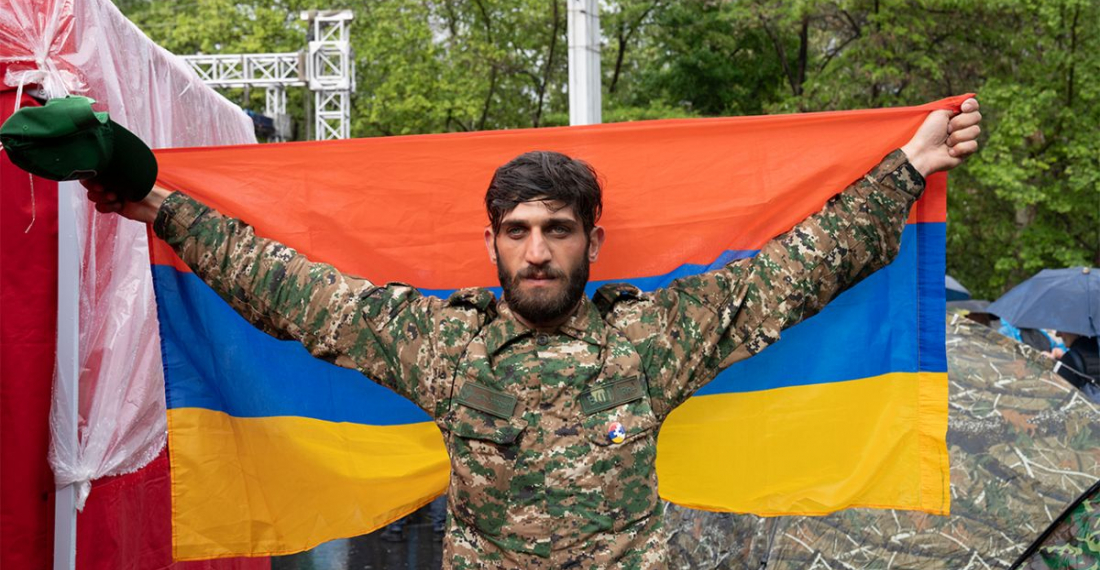For some there was a sense of deja vu.
Opponents of Armenian prime minister Nikol Pashinyan took to the streets of Yerevan this week with the declared aim of unseating him and his government. Spearheaded by supporters of former presidents Robert Kocharian and Serzh Sargsyan, and cadres from the small but disciplined ARF (Dashnak) party, thousands of demonstrators paralysed the main traffic streets of Yerevan calling for the prime minister’s resignation. The situation appears reminiscent to a similar situation last year when, in the aftermath of Armenia’s military defeat in the 44 day Karabakh War, similar protests took place. On that occasion, Pashinyan called early parliamentary elections in July 2021, which he won convincingly, after which the protests fizzled out.
This year, the protests were triggered by the decision of the Armenian government to move to normalise relations with both Azerbaijan and with Turkey. Negotiations with the government of both countries are now ongoing. Azerbaijan insisted that as a precondition to negotiations Armenia must recognise its territorial integrity. Pashinyan argues that since in fact Armenia had already done so years ago, under previous governments, this was not an issue. He also indicated that the Armenian claim for Karabakh independence had to be abandoned. Despite the ambiguity in the choice of words used by the Armenian leader – no doubt to leave room for manoeuvre in future negotiations – the opposition has been quick to describe this as a treasonable sell-out. In doing so it is hoping to rally around it not only its usual core of supporters which in the view of many are not enough to be able to force out Pashinyan, but a wider mass of Armenians who care about the future of Karabakh.
Street protests had been taking place for some weeks, but picked up pace recently, with a large rally, several thousand strong, held in Yerevan on Sunday (1 May). Speaking at the protest, opposition leader Ishkhan Sagatelyan rejected categorically the possibility of Nagorno-Karabakh being a part of Azerbaijan, adding that Pashinyan had “betrayed the people’s trust and must go”. He called for a “large scale campaign of civil disobedience to begin on Monday”, including national strikes, a boycott of classes by students, and a block to traffic in central Yerevan.
Protestors set up tents on main streets and erected barricades, blocking traffic on France Square, which connects major avenues in Yerevan. According to the most recent estimates, 244 of these protestors were arrested on Monday alone by Armenian police, and detained on charges of refusing to obey police orders.
The organisers of the protest have denounced what they say is an unnecessary use of “brutal force” by officers. Police have reportedly opened at least one investigation into allegations that unnecessary violence was used on 2 May.
Demonstrations have nonetheless continued unabated, and roadblocks have been set up at strategic locations, echoing the tactics used by Pashinyan during the 2018 Velvet Revolution, when the closure of streets was a key tactic in forcing the resignation of the then president, Serzh Sargsyan.
Protestors, who are reportedly dubbing themselves “the Resistance Movement” insist they will not be deterred, and have urged for the continued blocking of streets. They are calling for Pashinyan’s resignation, guarantees about the status of Nagorno-Karabakh, and the "de-Turkification of Armenia". According to some reports, up to 10,000 people have been attending the rallies.
As things stand, and barring some unforeseen development, most political observers do not think that the opposition has enough strength to bring down the government.
Pashinyan, a hardened veteran of the “Yerevan Street” appears to think so too, and his response, and that of his political allies, has been rather relaxed. Addressing parliament, as the street protests were ongoing, he once again emphasised the democratic nature of his government, insisting that “Democratic Armenia” will remain the country’s brand under his watch. He did however also say that democracy has its limits, hinting that the opposition should not push its luck.
Alen Simonyan, the Chairman of the Armenian Parliament, insisted that “there is no political crisis”. Hovik Aghazaryan, a member of the ruling party, said that while many protestors had “sincere motives”, they were being manipulated by leaders representing the former regime. Pashinyan’s allies have accused the opposition of exploiting the current situation in a bid to seize power, without any real plan as to how to resolve the Nagorno-Karabakh issue.
During an interview with CivilNet, Boris Navasardyan, the head of the Yerevan Press Club, said that the situation was “a crisis accompanied by a dead end”, since the current government “don't have a solution for the growing problems and the opposition doesn't have an alternative agenda that would provide those solutions”.
In the meantime, apart from the inconvenience of traffic disruptions, the Armenian government appeared to be going on with business as usual. The foreign minister was this week in Washington where he was congratulated for his government’s constructive approach to the resolution of the Karabakh conflict and lauded for its democratic credentials, and the Defence Minister was in Georgia for meetings with Georgian counterparts. Pashinyan himself will travel to Europe next week.
Perhaps more significantly, separate talks with Azerbaijan and with Turkey continued this week, not in secret, but in full view of the world media.
All this indicates that something fundamental is changing in the way Armenians think about their politics and about the future of their country, and that more pragmatic considerations may be replacing the nationalist euphoria of the 1990’s, which dragged on, even if unconvincingly, into the 21st century. This may mean that Pashinyan’s Achilles heel may turn out in the future not to be Karabakh, but the Armenian economy, and his ability to deliver a better quality of life to the Armenian people.



